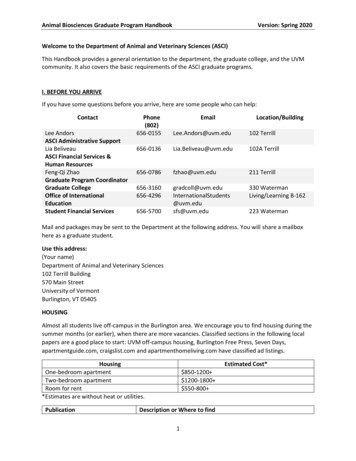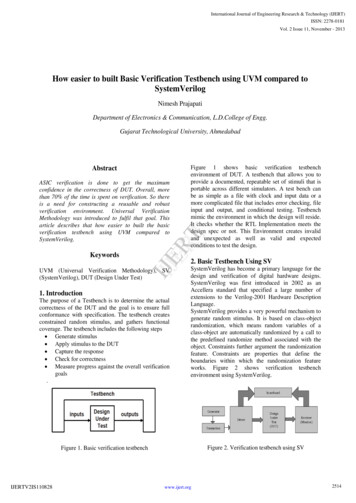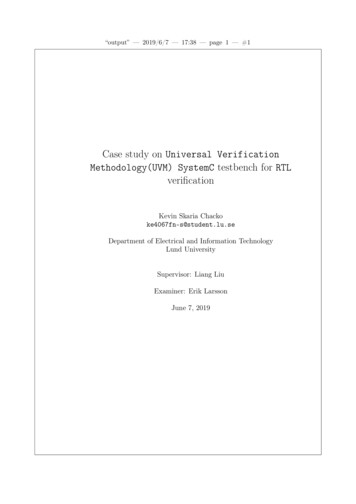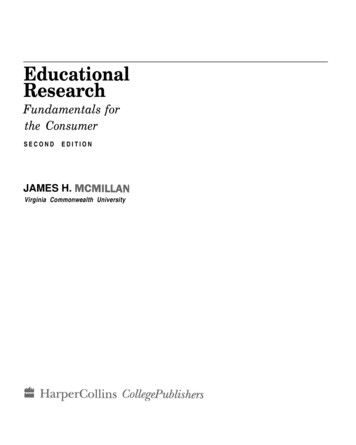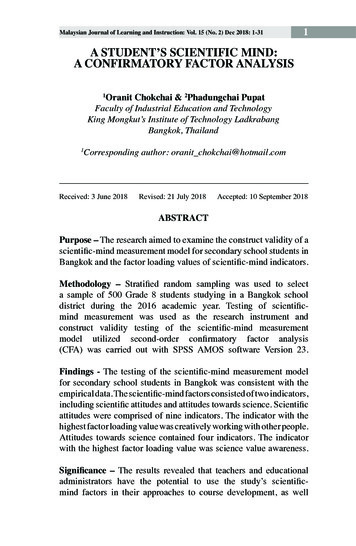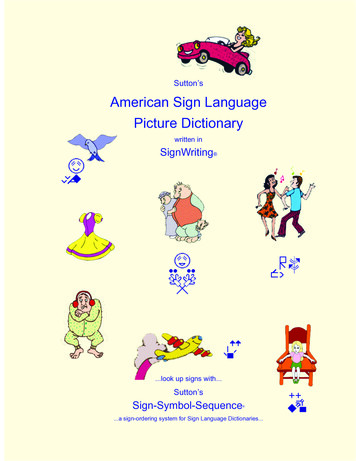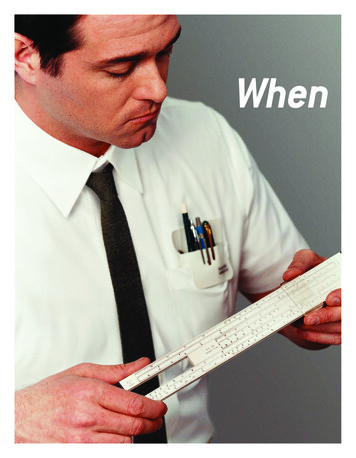
Transcription
When80SCIENTIFIC A MERIC A NM AY 2 0 0 6
Slide Rules RuledBefore electronic calculators, the mechanical slide ruledominated scientific and engineering computationTBy Cliff Stollwo generations ago a standard uniform identified engineers: white shirt, narrow tie, pocket protector and sliderule. The shirt and tie evolved into a T-shirt sporting somesoftware advertisement. The pocket protector has been replaced by a cell phone holster. And the slide rule has become anelectronic calculator.Take another look at that slide rule. Pull it out of the draweryou stashed it in 30 years ago or make one of your own [see boxon next page]. You’ll see why it was once so valuable.Before the 1970s the slide rule, or slipstick, was as commonas the typewriter or the mimeograph machine. A few seconds offiddling let scientists and engineers multiply, divide and findsquare and cube roots. With a bit more effort, techies could alsocompute ratios, inverses, sines, cosines and tangents.Inscribed with a dozen or more function scales, the slide rulesymbolized the mysteries of arcane science. Truth is, though,two scales did most of the work, as many technical jobs boileddown to multiplication and division. A pianist might play mostof the ivories on the keyboard, but rarely did any engineer useall the scales on his (almost never her) slide rule.Some engineers, perhaps bucking for promotion, wieldedslide rules made of exotic mahogany and boxwood; otherssported rules fashioned from ivory, aluminum or fiberglass.Cheapskates— including this author— carried plastic ones. Fromthe finest to the humblest, however, all slide rules were based onlogarithms [see box on page 85].Birth of the Slide RuleSCIENTIFIC A MERIC A NBR AD DECECCOjo h n n a p i e r , a Scottish mathematician, physicist and astronomer, invented logarithms in 1614. His Canon of Logarithms begins: “Seeing there is nothing that is so troublesometo mathematical practice, nor doth more molest and hinder calculators, than the multiplications, divisions, square and cubical81
DO-IT-YOURSELF SLIDE RULEx19861.575643522427 8 9 163 π8 9 17π 35438 9 1247823241.5563π80109Wrap the folded tapearound the slide rulefor sizing. Use the adhesiveend to complete the cursor.Slide cursor onto the rule.89682SCIENTIFIC A MERIC A N(Slider)1CLeft-hand .5DLS1.069772.181.5.2108063π42.37 8 9 1Hairline5556642Draw a line with a finemarker in the middle.751x²8 9 17b Cut herex²x³8 9 17 8 9 1434236030To make the cursor (thesliding window that isinscribed with a hairline),use the guides to the left tomeasure two pieces oftransparent tape. Make onesection the length of theblack line and the other thelength of the red line. Placethe adhesive sides together.55535Slip part B into the foldedpart A.75151575.4665Fold part A along thedotted lines.7cottan4545504023465253060Cut out the entire whitepanel (a). Cut along linebetween parts A and B (b),then remove excess (c).7020603050404050207013 π.5CHRIS HAM ANN AND NANCY S HAWlgxsincos70 9020 0x11 .098.97.865.74.6ASSEMBLY INSTRUCTIONS1–xc Cut herea Cut hereRight-hand indexYou can build a working slide rule from paper and cellophane tape. Photocopying these plans onto thicker paper yields areasonably robust calculating instrument. These construction plans are also available at www.sciam.com/onthewebPartBM AY 2 0 0 6
SCIENCE MUSEUM/SCIENCE AND SOCIE T Y PIC TURE LIBR ARYHOW TO USE A SLIDE RULEFirst, get your hands on a slide rule. The top stationary scaleusually has the A scale; the B and C scales reside on the centralslider. The D scale sits on the bottom stationary scale. The lefthand index is on the slider— it is the farthest left digit 1 on the Cscale. At the extreme right of the slider, you will find anothernumber 1 on the C scale — that is the right-hand index. Finally,the mobile cursor contains the hairline.To multiply two numbers, move the slider until the left-handindex points to the first number on the D scale. Now slide thecursor hairline over so it points to the second number on the Cscale. The answer will appear under the hairline on the D scale. Soto multiply 2 times 4, adjust the C scale until the left-hand indexpoints to 2 on the D scale. Move the hairline to rest over the 4 onthe C scale. You’ll find the answer, 8, right under the hairline onthe D scale .If your calculation extends off the end of the slide rule, usethe right-hand index. So to multiply 7 times 6, set the right-handindex over 7 on the D scale and the hairline over 6 on the C scale.Read 4.2 on the D scale and then remember that the slipperydecimal point must be shifted one place to the right to give thecorrect answer, 42.To divide, set the hairline over the dividend on the D scale.Then shift the slider until the divisor lies under the hairline (andright next to the dividend). The quotient will be under the index.For example, let’s divide 47 by 33. Move the cursor so that thehairline points to 4.7 on the D scale. Move the slider until 3.3 onthe C scale rests under the hairline. Now the left-hand index sitsadjacent to the answer, 1.42.Want to find the square of a number? You will not need tomove the slider. Just place the hairline over a number on the Dscale. Look up at the A scale, where the hairline points to thesquare. So, right above 7 on the D scale, you will find 4.9 on the Ascale. Slip the decimal point to the right to get the answer, 49.To determine square roots, there is no need to move theslider. But notice that the A scale is divided into two parts: theleft half runs from 1 to 10, and the right half goes from 10 to100. To find the square root of any number between 1 and 10,place the hairline over the number on the left side of the A scaleand read out the square root from the D scale. Use the right halfof the A scale to take the square root of numbers between 10and 100. When you write numbers in scientific notation, thosewith even exponents (such as 1.23 ! 10 4) will be found on theleft side of the A scale; those with odd exponents (such as1.23 ! 103) are on the right.You can discover quite a few shortcuts — for instance, thecursor works as a short-term memory in chaining calculations.Or try using the CI scale to prevent calculations from running offthe end of the slipstick.You will find additional scales on your homemade slide rule.The K scale is used for cubes and cube roots; the S and T scalesgive sines and tangents. The L scale gives the logarithm of anumber on the D scale.Try these on your homemade slipstick. With a bit of practice,you may be surprised at its ease of use and its utility.— C.S.w w w. s c ia m . c o mextractions of great numbers, which besides the tedious expense of time are for the most part subject to many slipperyerrors, I began therefore to consider in my mind by what certain and ready art I might remove those hindrances.”Yes, logarithms— that horror of high school algebra— wereactually created to make our lives easier. In a few generations,people will be equally shocked to learn that computers werealso invented to make our lives easier.So how did Napier’s logarithms work? Listen to the inventor: “Cast away from the work itself even the very numbersthemselves that are to be multiplied, divided, and resolvedinto roots, and putteth other numbers in their place whichperform much as they can do, only by addition and subtraction, division by two or division by three.”Which is to say that by using logs, multiplication simplifiesinto sums, division becomes subtraction, fi nding a squareroot turns into dividing by two, and figuring a cube root becomes dividing by three. For example, to multiply 3.8 by 6.61,you look up the logarithms of those numbers in a table. Thereyou will fi nd 0.58 and 0.82. Add these together to get 1.4.Now go back to the table and fi nd the number whose log is1.4 to get a close approximation of the answer: 25.12. Begoneye slippery errors!Napier’s invention revolutionized mathematics — mathematicians adopted it immediately to speed their calculations.German astronomer Johannes Kepler used these modern logarithms to calculate the orbit of Mars at the start of the 17thcentury. Without their assistance, he might never have discovered his three laws of celestial mechanics. Henry Briggs, England’s most eminent mathematician of the time, traveled toScotland just to meet Napier. He introduced himself with: “My lord, Ihave undertaken thislong journey purposely to see your person,and to know by whatengine of wit or ingenuity you came fi rstto think of this mostexcellent help untoSLIDE RULEwas invented byEnglish minister WilliamOughtred in 1622. RobertBissaker constructed the first sliderule whose slide fi t into a slot in a fi xedstock in 1654 (bottom). Henry Sutton’s sliderule (top) was an early circular rule (circa 1663).SCIENTIFIC A MERIC A N83
“Multiplicationjust required liningup two numbers andreading a scale.”probably felt that his invention was not worth much. After all,mathematicians created equations; they did not apply them.(This is still true today: making money often means finding anapplication for what someone else has developed.)For whatever reason, Oughtred failed to publish news ofhis invention, but one of his students, Richard Delamain,claimed in a 1630 pamphlet to have come up with the circularslide rule. More engineer than mathematician, Delamain wasdelighted with its portability, writing that it was “fit for useon Horse backe as on Foote.”OTIS KING, a Londonengineer, wrapped several feet ofscales around a pocket-size cylinder in 1921 toachieve a portable slide rule with impressive resolution.Denied credit for his invention, Oughtred was outraged.He rallied his friends, who accused Delamain of “shamelessnesse” and being the “pickpurse of another man’s wit.” Theargument would continue until Delamain’s death, serving neither man much good. Oughtred later wrote, “This scandallhath wrought me much prejudice and disadvantage.”Look Ma, No Logs!w i t h oug h t r e d’s i n v e n t ion in hand, no one neededa book of logarithms or even had to know what a log was.Multiplication just required lining up two numbers and reading a scale. It was quick and eminently portable. The slide rulewould automatically “cast away numbers.”A wonderful idea, yet slide rules took two centuries tocatch on. As late as 1850, British mathematician Augustus DeMorgan lamented the resistance: “For a few shillings, mostpersons might put into their pockets some hundred times asmuch power of calculation as they have in their heads.”The slide rule was improved and extended during the fi rsthalf of the 1800s. In a lecture before the Royal Society in 1814,Peter Roget (the creator of the thesaurus) described his invention, the log-log slide rule. With this tool, he could easily calculate fractional powers and roots, such as 30.6 to the 2.7thpower. The utility of the log-log rule, however, was not appreciated until 1900, when chemists, electrical engineers andphysicists began to face increasingly complex mathematics.It took a 19-year-old French artillery lieutenant— AmédéeMannheim— to popularize the slide rule. In 1850 he chose thefour most useful scales and added a movable cursor (a slidingpointer to line up numbers on the scales). Within a few years theFrench army adopted his device. When the Prussian infantry isattacking, who has time to aim a cannon using long division?In time, European engineers, surveyors, chemists and astronomers carried Mannheim’s improved slide rule. AfterWorld War I, American scientists began to adopt them. AllFABER-CASTELL 2/83N slide rule is considered by some to be the finest and most beautiful slide rule ever made.84SCIENTIFIC A MERIC A NM AY 2 0 0 6W W W.V I N T A G E C A L C U L A T O R S . C O M ( t o p) ; F A B E R - C A S T E L L A G ( b o t t o m)astronomy . . . I wonder why nobodyelse found it out before, when, now being known, it appears so easy.” Briggs recognizedgenius; Napier went on to invent the decimal point andcalculating rods (known as Napier’s bones) and to lay thegroundwork for Isaac Newton’s calculus.Napier had simplified computational tasks, but ready access to books of log tables was crucial to the procedure. So in1620 mathematician Edmund Gunter of London marked aruler with logarithms, which let his calculating colleagues findlogs without a trip to the library. Gunter drew a number linein which the positions of numbers were proportional to theirlogs. In his scale, succeeding numbers are spread out on theleft and squashed together at the right end. Two numbers couldnow be multiplied by measuring the distance from the beginning of the scale to one factor with a pair of dividers, thenmoving them to start at the other factor and reading the number at the combined distance.Around 1622 William Oughtred, an Anglican minister inEngland, placed two sliding wooden logarithmic scales nextto each other and created the first slide rule. A few years laterhe made a circular slide rule. Not that Oughtred crowed abouthis achievements. As one who loved pure mathematics, he
but the cheapest slide rules displayed squares and roots; mostalso computed cubes, cube roots, inverses, sines and tangents.Sophisticated ones might include hyperbolic functions to letelectrical engineers calculate vectors or help structural engineers find the shape of catenary curves, which are importantelements in suspension bridges, for instance. To pry more precision out of their slipsticks, manufacturers added magnifiersto better judge positions on scales, inscribed ever fi ner tickmarks and built longer slide rules. They mapped Napier’slogarithms onto circles, spirals, disks and cylinders.In 1921 London engineer Otis King spiraled a five-footlong logarithmic scale around an inch-diameter cylinder thatcould fit in a pocket. Engineers marveled at its four digits ofprecision. For even more exactitude, a scientist might investin Fuller’s Rule, the granddaddy of high-precision slide rules.A 41-foot logarithmic helix snakes around the exterior of afoot-long cylinder; by using a special indicator, it gives theprecision of an 83-foot scale, letting users do arithmetic withfive digits of resolution. The elaborate contraption might bemistaken for an engraved rolling pin.With few alternatives, techies adapted to slipsticks. In turn,slide-rule makers inscribed additional marks to speed calculations. Typically you could find pi, pi/4, the constant e (the baseof “natural” logarithms) on the scales, and occasionally cursor marks to convert inches to centimeters or horsepower towatts. Specialized slide rules appeared with molecular weightsfor chemists, hydraulic relations for shipbuilders and radioactive decay constants for atom bomb designers.By 1945 the log-log duplex slide rule had become ubiquitous among engineers. With nearly a dozen scales on eachside, it would let users raise a number to an arbitrary poweras well as handle sines, cosines and hyperbolic trigonometryfunctions with ease. During World War II, American bombardiers and navigators who required quick calculations often used specialized slide rules. The U.S. Navy designed ageneric slide rule “chassis,” with an aluminum body and plastic cursor, into which celluloid cards could be inserted for specialized calculations of aircraft range, fuel use and altitude.By the 1960s you could not graduate from engineeringschool without a week’s instruction in the use of a slipstick.Leather-cased slide rules hung from belts in every electricalengineering department; the more fashionable sported sliderule tie clips. At seminars, you could tell who was checkingthe speaker’s numbers. High-tech fi rms gave away slide rulesimprinted with company trademarks to customers and prospective employees.High Noon for the Slipstickc o n s i d e r t h e e n g i n e e r i n g achievements that owetheir existence to rubbing two sticks together: the Empire StateBuilding; the Hoover Dam; the curves of the Golden GateBridge; hydromatic automobile transmissions; transistor radios;the Boeing 707 airliner. Wernher Von Braun, the designer of theGerman V-2 rocket and the American Saturn 5 booster, reliedon a rather plain slide rule manufactured by the German comw w w. s c ia m . c o mLogarithm LogAbit fuzzy about logarithms? Here is a short summary:If ax m, then x, the exponent, can be said to be thelogarithm of m to the base a. Although a can be anynumber, let us focus on common logarithms, or the logs ofnumbers where a 10. The common log of 1,000 is 3because raising 10 to the third power, 103, is 1,000.Conversely, the antilog of 3 is 1,000; it is the result ofraising 10 to the third power.Exponents do not have to be integers; they can befractions. For example, 100.25 equals about 1.778, and 103.7equals about 5,012. So the log of 1.778 is 0.25, and the log of5,012 is 3.7.When you express everything in terms of 10 to a power,you can multiply numbers by just adding the exponents. So100.25 times 103.7 is 103.95 (10 0.25 3.7). What does 103.95equal? Look up the antilog of 3.95 in a log table, and you’llfind 8,912, which is indeed about equal to the product of1.778 and 5,012. (Common logs can be found by entering“log (x)” into Google, for example, or by consulting log tablesin libraries.)Just as multiplication simplifies to addition, divisionbecomes subtraction. Here is how to divide 759 by 12.3using logs. Find the logs of 759 and 12.3: 2.88 and 1.09.Subtract 1.09 from 2.88 to get 1.79. Now look up the antilogof 1.79 to get the answer, 61.7.Need to calculate the square root of 567.8? Justdetermine its log: 2.754. Now divide that by 2 to get 1.377.Find the antilog of 1.377 for the answer: 23.82.Naturally, complications arise. Log tables list only themantissa — the decimal part of the log. To get the truelogarithm, you must add an integer (called the characteristic) to the mantissa. The characteristic is the number ofdecimal places to shift the decimal point of the associatednumber. So to find the log of 8,912, you would consult a logtable and see that the log of 8.912 is 0.95. You would thendetermine the characteristic of 8,912, which is 3 (becauseyou must shift the decimal point three places to the left toget from 8,912 to 8.912). Adding the char acter istic to themantissa yields the true common log: 3.95.Because common logs are irrational (a numberexpressed as an infinite decimal with no periodic repeats)and log tables have limited precision, calculations using logscan provide only close approximations, not exact answers.Logarithms show up throughout science: Chemistsmeasure acidity using pH, the negative log of a liquid’shydrogen ion concentration. Sound intensity in decibels is10 times the log of the intensity divided by a referenceintensity. Earthquakes are often measured on the Richterscale, which is built on logarithms, as are the apparentbrightness magnitudes of stars and planets.Finally, logs pop up in everyday usage. Many graphs thatdepict large numbers employ logarithmic scales that mapnumbers by orders of magnitude (10, 100, 1,000 and soforth) — the same scales that appear on slide rules.— C.S.SCIENTIFIC A MERIC A N85
Yet slide rules had an Achilles’ heel; standard modelscould typically handle only three digits of precision. Finewhen you are figuring how much concrete to pour down ahole but not good enough for navigating the path of a translunar space probe. Worse yet: you have to keep track of thedecimal place. A hairline pointing to 3.46 might also represent 34.6, 3,460 or 0.00346.That slippery decimal place reminded every competentengineer to double-check the slide rule’s results. First youwould estimate an approximate answer and then compare itwith the number under the cursor. One effect was that usersfelt close to the numbers, aware of rounding-off errors andsystematic inaccuracies, unlike users of today’s computerdesign programs. Chat with an engineer from the 1950s, andyou will most likely hear a lament for the days when calculation went hand-in-hand with deeper comprehension. Instead“The slide rule helpedto design the verymachines that wouldrender it obsolete.calculating numbers. This 1953 advertisement foreshadowed thechanges that would occur when electronic calculators and digitalcomputers began to come into more common use.THE AUTHORpany Nestler. Indeed, the Pickett company made slide rulesthat went on several Apollo missions, as backup calculatorsfor moon-bound astronauts. Soviet engineer Sergei Korolevused a Nestler rule when he designed the Sputnik and Vostokspacecraft. It was also the favorite of Albert Einstein.86CLIFF STOLL is best known for breaking up a ring of hackers during the early days of the Internet, as described in his book TheCuckoo’s Egg. His other books are High Tech Heretic: Why Computers Don’t Belong in the Classroom and Silicon Snake Oil. Stollreceived a doctorate in planetary science from the University ofArizona and now makes Klein bottles and teaches physics toeighth graders. In his previous life, he worked at the Space Telescope Science Institute, the Purple Mountain Observatory inChina, the Kitt Peak National Observatory, the Keck Observatory and the Harvard-Smithsonian Center for Astrophysics. Stolland his wife live in Oakland, Calif.; the log of the number of theirchildren is about 0.301, and they have almost 100.4772 cats. Theauthor would like to thank Regina McLaughlin, Bob Otnes andWalter Shawlee for their help with this article.SCIENTIFIC A MERIC A NM AY 2 0 0 6IBM CORP OR ATION“COMPUTERS” used to refer to humans who spent their time”of plugging numbers into a computer program, an engineerwould understand the fine points of loads and stresses, voltages and currents, angles and distances. Numeric answers,crafted by hand, meant problem solving through knowledgeand analysis rather than sheer number crunching.Still, with computation moving literally at a hand’s paceand the lack of precision a given, mathematicians worked tosimplify complex problems. Because linear equations werefriendlier to slide rules than more complex functions were,scientists struggled to linearize mathematical relations, oftensweeping high-order or less significant terms under the computational carpet. So a car designer might calculate gas consumption by looking mainly at an engine’s power, while ignoring how air friction varies with speed. Engineers developed shortcuts and rules of thumb. At their best, thesemeasures led to time savings, insight and understanding. Onthe downside, these approximations could hide mistakes andlead to gross errors.Because engineers relied on imperfect calculations, theynaturally designed conservatively. They made walls thickerthan need be, airplane wings heavier, bridges stronger. Suchoverengineering might benefit reliability and durability, butit cost dearly in overconstruction, poorer performance andsometimes clumsy operation.The difficulty of learning to use slide rules discouragedtheir use among the hoi polloi. Yes, the occasional grocerystore manager figured discounts on a slipstick, and this authoronce caught his high school English teacher calculating statsfor trifecta horse-race winners on a slide rule during study
PICKET T N600-ES slide rule traveled with the NASA Apollo spacecraft to the moon as a backup calculator.hall. But slide rules never made it into daily life because youcould not do simple addition and subtraction with them, notto mention the difficulty of keeping track of the decimal point.Slide rules remained tools for techies.The Fall of the Slide Rulef o r t h e f i r s t h a l f of the 20th century, gear-drivenmechanical calculators were the main computational competitors to slide rules. But by the early 1960s, electronics beganto invade the field. In 1963 Robert Ragen of San Leandro, Calif., developed the Friden 130 — one of the first transistorizedelectronic calculators. With four functions, this desktop machine amazed engineers by silently calculating to 12 digits ofprecision. Ragen recalls designing this electronic marvel entirely with analog tools: “From the transistor bias currents tothe memory delay lines, I fleshed out all the circuitry on myKeuffel & Esser slide rule.” The slide rule helped to design thevery machines that would ultimately render it obsolete.By the late 1960s you could buy a portable, four-functioncalculator for a few hundred dollars. Then, in 1972, HewlettHP-35 POCKET CALCUL ATORE R I C M A R C O T T E ( t o p) ; R I C K F U R R ( b o t t o m)sounded the death knell forthe slide rule. Introduced byHewlett-Packard in 1972,the 395 handheld devicecombined large-scaleintegration circuits (sixchips in all) with a lightemitting diode display.It was powered bybatteries or anAC adapter.Packard built the fi rst pocket scientific calculator, the HP-35.It did everything that a slide rule could do — and more. Itsinstruction manual read, “Our object in developing the HP35 was to give you a high-precision portable electronic sliderule. We thought you’d like to have something only fictionalheroes like James Bond, Walter Mitty or Dick Tracy are supposed to own.”Dozens of other manufacturers soon joined in: Texas Instruments called their calculator product the “Slide Rule Calculator.” In an attempt to straddle both technologies, FaberCastell brought out a slide rule with an electronic calculatoron its back.The electronic calculator ended the slipstick’s reign. Keuffel& Esser shut down its engraving machines in 1975; all theother well-known makers — Post, Aristo, Faber-Castell andPickett— soon followed suit. After an extended production runof some 40 million, the era of the slide rule came to a close.Tossed into desk drawers, slide rules have pretty much disappeared, along with books of five-place logarithms and pocketprotectors.Today an eight-foot-long Keuffel & Esser slide rule hangson my wall. Once used to teach the mysteries of analog calculation to budding physics students, it harkens back to a daywhen every scientist was expected to be slide-rule literate.Now a surfboard-size wall hanging, it serves as an icon ofcomputational obsolescence. Late at night, when the house isstill, it exchanges whispers with my Pentium. “Watch out,” itcautions the microprocessor. “You never know when you’repaving the way for your own successor.”MORE TO EXPLOREA History of the Logarithmic Slide Rule and Allied Instruments. FlorianCajori. First published in 1909. Reprinted by Astragal Press, 1994.Slide Rules: Their History, Models and Makers. Peter M. Hopp.Astragal Press, 1999.Basic slide-rule instructions: www.hpmuseum.org/srinst.htmInteractive slide-rule ide.htmlPeter Fox offers an explanation of logarithms and slide rules atwww.eminent.demon.co.uk/sliderul.htmThe Oughtred Society, dedicated to the preservation and history ofslide rules and other calculating instruments: www.oughtred.orgSlide-rule discussion forum: groups.yahoo.com/group/slideruleWalter Shawlee’s Sphere Research’s Slide Rule Universe sells slide rulesand related paraphernalia: www.sphere.bc.ca/test/sruniverse.htmlSCIENTIFIC A MERIC A N87
SCIENTIFIC AMERICAN 81 T wo generations ago a standard uniform identifi ed engi-neers: white shirt, narrow tie, pocket protector and slide rule. The shirt and tie evolved into a T-shirt sporting some software advertisement. The pocket protector has been re-placed by a cell phone holster

